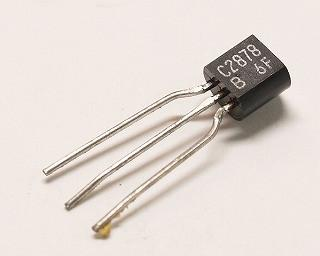2SC2878
Part Number: 2SC2878
Manufacturer: Toshiba
Description: Bipolar Transistors – BJT
Shipped from: Shenzhen/HK Warehouse
Stock Available: Check with us
ICRFQ.com - Electronic Components Distributor in China Since 2003

Part Number: 2SC2878
Manufacturer: Toshiba
Description: Bipolar Transistors – BJT
Shipped from: Shenzhen/HK Warehouse
Stock Available: Check with us
The 2SC2878 is a Transistor Used in Applications That Involve Muting and Switching. The minimum value for its high emitter-base voltage is 25 volts, while the typical value for its high h reverse hFE is 150 volts.
The muting transistor and its audio application are likely the least well-known and understood when it comes to semiconductors. Very little information about this topic can be found on the internet, and the material that can be found is not very reliable.
Muting circuits can be used in a wide variety of situations. These include pre-amplifiers, audio amplifiers, audio mixers, and audio line and level equipment. Also included are synthesizers (both consumer and professional). The purpose of the muting circuit found in amplifiers and pre-amplifiers is to prevent the popping sound made by loudspeakers when power is given to the device. The muting circuit in mixers and other audio lines and level equipment can also be used to choose and deselect different input channels; however, this process must be carried out cleanly or quietly.
It should come as no surprise that the purpose of muting circuits is to silence or “kill” the audio signal. Switches relay contacts, analog switches, junction FETs, and bipolar muting transistors are some electronic components that can be utilized to accomplish this task. Because of a contact bounce, the contacts on switches and relays can be noisy and intermittent. In addition, correctly applied contacts have to be rated for use in dry circuits because of the low current and potential difference across the contacts.
This necessitates bifurcated dry circuit contacts, a specialized, high-priced type of contact. It is possible to utilize a junction FET as a variable attenuator; however, using it as a muting device is incorrect due to its lack of symmetry. Because of the inherent body diode, the device cannot withstand over 600 millivolts of voltage. Analog switches can do the job if appropriately utilized, but they lack the audio range for professional line and level applications, are prone to crosstalk, and are vulnerable to ESD (ESD). On the other hand, the bipolar muting transistor can do everything exceptionally well and is affordable.
The structure of a conventional NPN transistor is symmetrical in the sense that it is made up of three layers: two layers of “N” material (the Collector and the emitter), with one layer of “P” material in between them (base). However, this is the extent to which the symmetry extends, as the layer thicknesses and doping substantially vary. In this mode, the standard transistor’s hFE (current gain) is lowered by perhaps two orders of magnitude, and the reversed voltage rating (Vebo) is generally limited to around 5V. However, the standard transistor can still function with switched Collector and emitter terminals.
In comparison, the muting transistor is quite a bit more symmetrical. It has a high reverse hFE, and specific versions have a reverse voltage rating of 15 to 40 volts from the base to the emitter (Vbeo). In practice, it is rated for operation with AC, which works very well with audio voltage signals that are, by their very nature, AC. The emitter terminal or Collector with the highest negative value is the one that emits light.
It is necessary to apply a sufficient base drive to saturate either polarity, exactly what is needed to make the silent function work.
The base-to-emitter reverse voltage rating provides a grade for each category (Vbeo). The Vbeo of the first category is restricted to 5V and is ideal for use in consumer electronics with an average program signal level of -7.8dbu (0.315Vrms or 0.445Vpeak). A device with a rating of 5V offers 21 dB of headroom to accommodate the transients present in the program material.
The second category of Vbeo begins at 15V and is designed for the line and level devices used in professional recording studios. These devices typically have an average program signal level of +4dbu (1.228Vrms or 1.736Vpeak). When handling program material transients, a device with a rating of 15V offers 18.7db of headroom.
Muting transistors frequently fail and are vulnerable to ESD. The output connector is where they are used in the circuit, not because they are unique from other semiconductors. The widespread usage of the outdated, subpar RCA phono jack connector, which creates first contact with the muting transistor before the ground sleeve establishes the connection and forces any charge directly into the transistor, is, in my opinion, the primary cause of failure.
The transistor is damaged or destroyed by this discharge. Although ESD protection may be offered or enhanced, I think that the transistor or the ESD protection device will eventually fail first. The easiest way to minimize ESD damage is to touch the connector’s sleeve to the chassis before plugging it in. Also, keep in mind that cables have two ends. Keep in mind that only the relay approach is immune to ESD.
We hope that you have picked up some helpful information from this article. If you have any questions, please do not hesitate to leave them in the comment areas below, and we will try our best to respond to them. Please browse our website at your leisure to acquire additional information; we have plenty of helpful content there.
Contact us here at ICRFQ, your leading electronic distributor in china, if you require information or want to place an order for part 2SC2878, and we will ensure that you receive the best product at the best price possible.
WhatsApp us